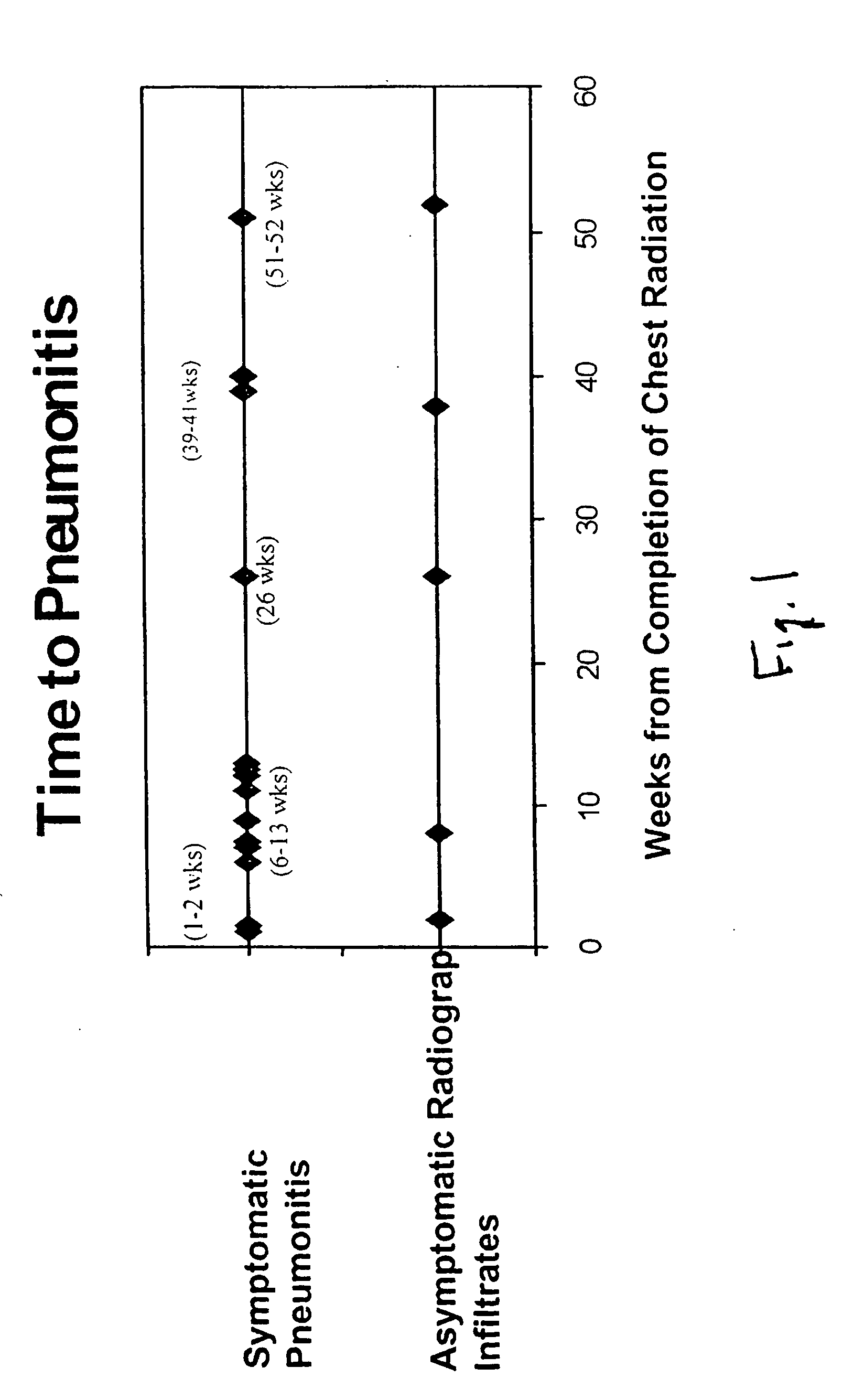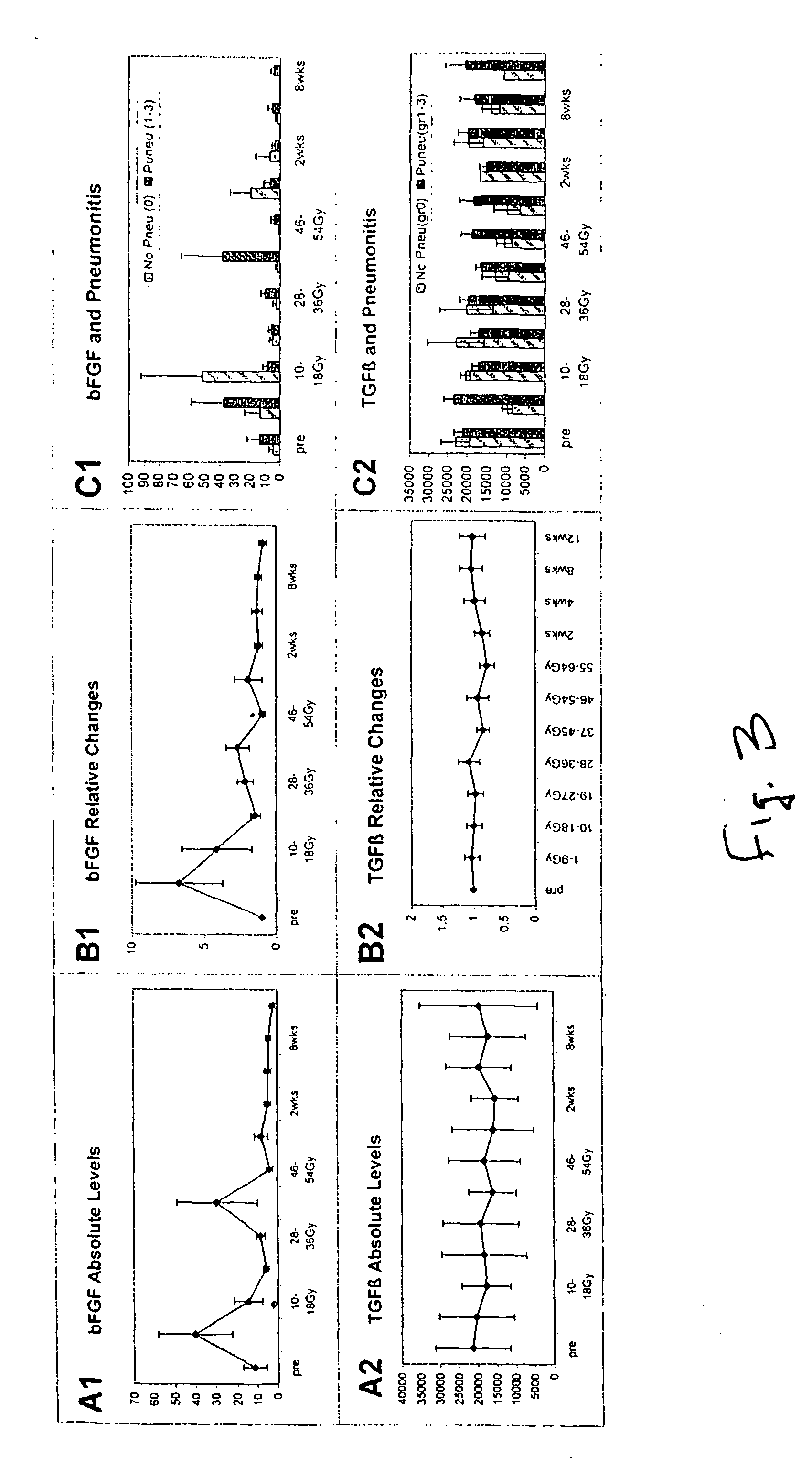Prevention of and therapy for radiation toxicity of normal tissues using drugs which block il-1 activity
a technology of il-1 activity and radiation toxicity, which is applied in the direction of drug composition, peptide/protein ingredients, peptides, etc., can solve the problems of radiation-related side effects still occurring, few if any radiation exposure treatment quantitative dose modifying benefits, and subject to full function, so as to prevent the progression of toxicity and prevent the effect of toxicity
- Summary
- Abstract
- Description
- Claims
- Application Information
AI Technical Summary
Benefits of technology
Problems solved by technology
Method used
Image
Examples
example 1
[0029] Materials and Methods: Prospective blood sampling, scoring of respiratory symptoms, and chest imaging were conducted for patients receiving thoracic radiation for malignancy. Serial plasma specimens were analyzed for circulating cytokine changes before, during radiation, and up to 12 weeks post-radiation. Radiation pneumonitis was diagnosed using NCI common Toxicity Criteria. Cytokine analysis was assayed for interleukin a (IL-1α), interleukin 6 (IL-6), Monocyte Chemotactic Protein 1 (MCP-1), E-Selectin, L-Selectin, Transforming Growth Factor β1 (TGF-β1), and Basic Fibroblast Growth Factor (bFGF) using Enzyme Linked Immmunosorbant Assay (ELISA).
[0030] Methods
[0031] Patients who were to receive thoracic radiation for malignancy were eligible. Blood, thoracic imaging, and respiratory symptom scoring were collected prospectively. Twenty-four patients had follow-up longer than 12 months and their characteristics are shown in Table 1.
TABLE 1Patient Cha...
example 2
[0049] Materials and Methods
Mice Strains and Radiation Treatment
[0050] Six to 7 week-old female C3H / HeN, BALB / c and C57BL / 6 mice were used (Jackson Laboratories, Bar Harbor, Me.). The right hind leg (10 mice per group) was given 10, 20, 30, 40, 60, or 80 Gy in a single radiation dose with a Shephered Irradiator, a 6000 Ci Cs source, together with collimating equipment. The left, non-irradiated hind leg was used as the non-irradiated control. Mice were sacrificed at different time points after radiation (0.5, 1, 2, 4, 8, 12hrs, day 1, day 7, and day 14). At least 10 mice were used at each time point. Tissues from 3 mice were used for histology, and the remaining animals were used for mRNA analysis. Skin and muscle tissues from control and irradiated legs were dissected, and total RNA was isolated. Guidelines for the humane treatment of animals were followed as approved by the University of Rochester Committee on Animal Resources.
Tumor Tissue RNA Isolation and RNase Protection As...
example 3
[0132] Material and Methods
Tumor Models and Radiation Treatment
[0133] Isotransplantable murine MCa-35 mammary tumor cells was inoculated i.m. into right hind thighs of 6-7 week-old female C3H / HeN mice (NCI, Fredrick, Md.). Right hind thigh tumors were given 60 Gy (single dose using a Cs irradiator) when tumors reached 8-9 mm in diameter. Mice were sacrificed 20 days after radiation.
[0134] Tumors and the overlaying skin tissues were removed for histology and RNA preparation. Irradiated tissues (tumor and skin) were also collected for making paraffin blocks for immunohistochemical staining. Guidelines for the humane treatment of animals were followed as approved by the University of Rochester Committee on Animal Resources.
Celebrex Treatment
[0135] Celebrex (Pfizer Inc.) powder was dissolved in PBS. Due to partial dissolution, the agent was mixed very well every time before gavaging. 50 mg / kg (0.2 ml) Celebrex was given daily, and five days per week for constitutive three weeks. ...
PUM
| Property | Measurement | Unit |
|---|---|---|
| time | aaaaa | aaaaa |
| time | aaaaa | aaaaa |
| diameter | aaaaa | aaaaa |
Abstract
Description
Claims
Application Information
 Login to View More
Login to View More - R&D
- Intellectual Property
- Life Sciences
- Materials
- Tech Scout
- Unparalleled Data Quality
- Higher Quality Content
- 60% Fewer Hallucinations
Browse by: Latest US Patents, China's latest patents, Technical Efficacy Thesaurus, Application Domain, Technology Topic, Popular Technical Reports.
© 2025 PatSnap. All rights reserved.Legal|Privacy policy|Modern Slavery Act Transparency Statement|Sitemap|About US| Contact US: help@patsnap.com



